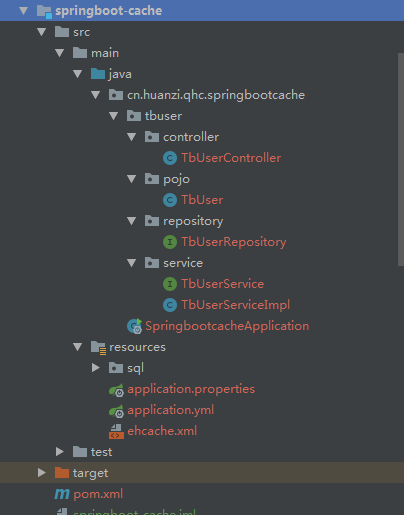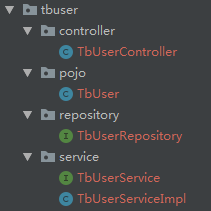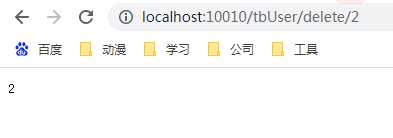SpringBoot系列——cache缓存
前言
日常开发中,缓存是解决数据库压力的一种方案,通常用于频繁查询的数据,例如新闻中的热点新闻,本文记录springboot中使用cache缓存。
官方文档介绍:https://docs.spring.io/spring-boot/docs/2.1.0.RELEASE/reference/htmlsingle/#boot-features-caching-provider-generic
工程结构

代码编写
pom引入依赖,引入cache缓存,数据库使用mysql,ORM框架用jpa
<!--添加springdata-cache依赖 -->
<dependency>
<groupId>org.springframework.boot</groupId>
<artifactId>spring-boot-starter-cache</artifactId>
</dependency>
<!-- 引入ehcache支持 -->
<dependency>
<groupId>net.sf.ehcache</groupId>
<artifactId>ehcache</artifactId>
</dependency>
<!--添加springdata-jpa依赖 -->
<dependency>
<groupId>org.springframework.boot</groupId>
<artifactId>spring-boot-starter-data-jpa</artifactId>
</dependency>
<!--添加MySQL驱动依赖 -->
<dependency>
<groupId>mysql</groupId>
<artifactId>mysql-connector-java</artifactId>
</dependency>
配置文件
server.port=10010 spring.application.name=springboot-cache spring.cache.type=ehcache spring.cache.ehcache.config=classpath:/ehcache.xml
ehcache.xml
<?xml version="1.0" encoding="UTF-8"?>
<ehcache xmlns:xsi="http://www.w3.org/2001/XMLSchema-instance" xsi:noNamespaceSchemaLocation="http://ehcache.org/ehcache.xsd" updateCheck="false">
<!-- 磁盘缓存位置 -->
<diskStore path="java.io.tmpdir"/>
<!-- maxEntriesLocalHeap:堆内存中最大缓存对象数,0没有限制 -->
<!-- maxElementsInMemory: 在内存中缓存的element的最大数目。-->
<!-- eternal:elements是否永久有效,如果为true,timeouts将被忽略,element将永不过期 -->
<!-- timeToIdleSeconds:发呆秒数,发呆期间未访问缓存立即过期,当eternal为false时,这个属性才有效,0为不限制 -->
<!-- timeToLiveSeconds:总存活秒数,当eternal为false时,这个属性才有效,0为不限制 -->
<!-- overflowToDisk: 如果内存中数据超过内存限制,是否要缓存到磁盘上 -->
<!-- statistics:是否收集统计信息。如果需要监控缓存使用情况,应该打开这个选项。默认为关闭(统计会影响性能)。设置statistics="true"开启统计 -->
<!--
默认缓存
无过期时间,但 600 秒内无人访问缓存立即过期
-->
<defaultCache
maxElementsInMemory="1000"
eternal="false"
timeToIdleSeconds="600"
timeToLiveSeconds="0"
overflowToDisk="false">
</defaultCache>
<!--
xx业务缓存
在有效的 120 秒内,如果连续 60 秒未访问缓存,则缓存失效。
就算有访问,也只会存活 120 秒。
-->
<cache name="myCache"
maxElementsInMemory="1000"
eternal="false"
timeToIdleSeconds="120"
timeToLiveSeconds="0"
overflowToDisk="false">
</cache>
</ehcache>
先写一个套tb_user表的CRUD代码

@RestController @RequestMapping("/tbUser/") public class TbUserController { @Autowired private TbUserService tbUserService; //方便测试暂时改成GetMapping @GetMapping("list") // @PostMapping("list") public List<TbUser> list(TbUser entityVo) { return tbUserService.list(entityVo); } @GetMapping("get/{id}") public TbUser get(@PathVariable("id")Integer id) { return tbUserService.get(id); } //方便测试暂时改成GetMapping @GetMapping("save") // @PostMapping("save") public TbUser save(TbUser entityVo) { return tbUserService.save(entityVo); } @GetMapping("delete/{id}") public Integer delete( @PathVariable("id") Integer id) { return tbUserService.delete(id); } }
opjo实体类要实现序列化
@Entity @Table(name = "tb_user") @Data public class TbUser implements Serializable { @Id @GeneratedValue(strategy= GenerationType.IDENTITY) private Integer id;//表id private String username;//用户名 private String password;//密码 private Date created;//创建时间 private Integer descriptionId;//关联详情id }
serviceImpl中,使用注解来开启缓存
@Service @Transactional @CacheConfig(cacheNames = {"myCache"}) public class TbUserServiceImpl implements TbUserService{ @PersistenceContext private EntityManager em; @Autowired private TbUserRepository tbUserRepository; //@Cacheable缓存数据:key为userList,value为返回值List<TbUser> @Cacheable(key = "'userList'") @Override public List<TbUser> list(TbUser entityVo) { System.out.println("获取list用户列表缓存数据,"+new Date()); return tbUserRepository.findAll(Example.of(entityVo)); } //@Cacheable缓存数据:key为参数id,value为返回值TbUser @Cacheable(key = "#id") @Override public TbUser get(Integer id) { System.out.println("获取数据缓存,key:"+id); Optional<TbUser> optionalE = tbUserRepository.findById(id); if (!optionalE.isPresent()) { throw new RuntimeException("ID不存在!"); } return optionalE.get(); } //@CachePut缓存新增的或更新的数据到缓存,其中缓存的名称为people,数据的key是person的id @CachePut(key = "#entityVo.id") // @CacheEvict从缓存中删除key为参数userList的数据 @CacheEvict(key = "'userList'") @Override public TbUser save(TbUser entityVo) { System.out.println("新增/更新缓存,key:"+entityVo.getId()); //entityVo传啥存啥,会全部更新 return tbUserRepository.save(entityVo); } //清空所有缓存 @CacheEvict(allEntries=true) @Override public Integer delete(Integer id) { System.out.println("清空所有缓存"); tbUserRepository.deleteById(id); return id; } }
效果演示
http://localhost:10010/tbUser/save?id=2&username=李四
调用save方法,key为2,value为当前tbUser对象的数据被缓存下来


http://localhost:10010/tbUser/get/2
当我们调用get方法时,直接获取缓存数据,控制台啥也不打印,连serviceImpl的get方法都不进去(可以打断点调试)


http://localhost:10010/tbUser/save?id=2&username=王五
当我们再次调用save方法更新username时,缓存数据也被更新


http://localhost:10010/tbUser/get/2
再次调用get接口,直接返回缓存数据,后台也是方法都不进去,啥也不打印


http://localhost:10010/tbUser/delete/2
调用delete接口,删除数据,同时删除缓存


再次调用get接口,发现缓存数据被清除,查询数据库

http://localhost:10010/tbUser/list
首次调用list接口,key为userList的,value为用户集合数据被缓存下来,再次调用直接返回缓存数据


当调用save接口,数据更新,删除key为userList的缓存,再次调用list时,重新查库并设置缓存

我们配置了缓存发呆时间,当120秒内未使用该缓存,立即过期,一直用就会一直存在
我们先同时访问两个接口list、get,list接口2分钟后再次访问,get接口不能超过2分钟是不是访问一下,结果如预期

PS:原先使用了这个jar包,有报错
<dependency>
<groupId>org.ehcache</groupId>
<artifactId>ehcache</artifactId>
<version>3.8.1</version>
</dependency>
后面改成用上面“代码编写”里pom中引的jnet.sf.ehcache下面的ar
后记
缓存除了能缓解数据库压力,还能做用户登录状态控制,例如:用户登录成功后cookie中保存颁发的token令牌设置永不过期,缓存存活时间也设置永不过期,发呆时间设置1天,这样只有用户在1天内有访问缓存接口,那他就可以一直保留登录状态,直至有其他业务将token或者缓存清掉。
springboot使用cache缓存暂时先记录到这,后续有空再进行补充。
代码开源
代码已经开源、托管到我的GitHub、码云:
GitHub:https://github.com/huanzi-qch/springBoot
码云:https://gitee.com/huanzi-qch/springBoot
版权声明
捐献、打赏

支付宝

微信
交流群






【推荐】编程新体验,更懂你的AI,立即体验豆包MarsCode编程助手
【推荐】凌霞软件回馈社区,博客园 & 1Panel & Halo 联合会员上线
【推荐】抖音旗下AI助手豆包,你的智能百科全书,全免费不限次数
【推荐】博客园社区专享云产品让利特惠,阿里云新客6.5折上折
【推荐】轻量又高性能的 SSH 工具 IShell:AI 加持,快人一步
· 没有源码,如何修改代码逻辑?
· 一个奇形怪状的面试题:Bean中的CHM要不要加volatile?
· [.NET]调用本地 Deepseek 模型
· 一个费力不讨好的项目,让我损失了近一半的绩效!
· .NET Core 托管堆内存泄露/CPU异常的常见思路
· 微软正式发布.NET 10 Preview 1:开启下一代开发框架新篇章
· 没有源码,如何修改代码逻辑?
· NetPad:一个.NET开源、跨平台的C#编辑器
· PowerShell开发游戏 · 打蜜蜂
· 在鹅厂做java开发是什么体验